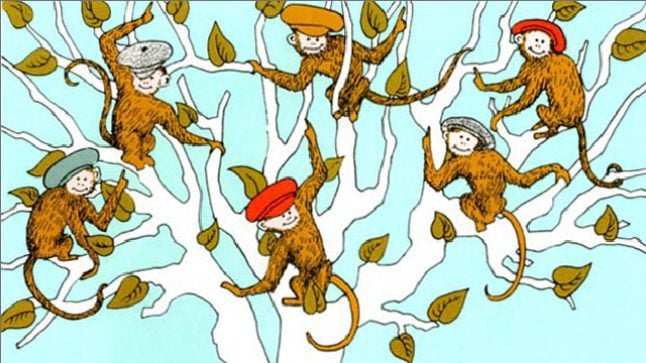Series: Book Ideas
Counting on Caps for Sale

The award winning classic children’s story Caps for Sale by Esphyr Slobodkina is not an especially mathematical story. However, it is one that preschoolers love to act out. Before beginning the dramatization, use discussion to make some connections to the children’s own lives. How many caps do they wear at a time? Just one? How about the mischievous monkeys in the story? As you talk about the story, you can check for their understanding of 1-to-1 correspondence. Do they see that the number of caps will be equal to the number of monkeys?
You can go on to ask the children if they can act out the story so that the number of monkeys in the book will match the number of children playing the monkeys. Be sure to enlist their help figuring out this problem. In doing so, you will be able to assess the children’s ability to estimate as well as their understanding and skill in using 1-to-1 correspondence.
Refer the children to the double spread picture of the monkeys in the tree. Remind them of how many children there are in the class. Then ask them to estimate if there are:
- More monkeys than children in the class,
- Fewer (not as many) monkeys than children in the class,
- About the same number of children and monkeys.
Record the children’s estimates and some comments about estimations. Depending on the level of the children, either have them count along with you or have them count how many monkeys are in the tree.
It is likely that children will find it hard to keep track of which monkeys they counted and which they didn’t. Ask if the children have any ideas of how they can keep track of the monkeys so each is counted only once. Some may suggest using a post-it or some other kind of marker on the page. However, you can also turn to the picture of the salesman settling under the tree with all the caps stacked in groups of 4 on his head. Ask if this picture would make it easier to see how many monkeys there are. Some children should be able to explain that since each monkey gets a cap, if you count the number of caps, you will know the number of monkeys. Children who have difficulty understanding this point have not yet mastered the principle of 1-to-1 correspondence.
If there are more or less children in the class than the monkeys, involve the children in further mathematical thinking. Discuss alternative ways to do the acting out.
- If there are more children than monkeys in the book, do all the children want to be included? If so, how many caps will be needed? (You can have the children make their own using paper plates.) If you only use the number in the story, what can the children who are not the monkeys do?
- If there are fewer children than monkeys in the book, how many caps will be needed? How many less than the number of monkeys in the book?
All of this rich mathematical thinking is likely to deeply engage the children in a way that a worksheet never could—that’s what happens when we mathematize using authentic playful situations.